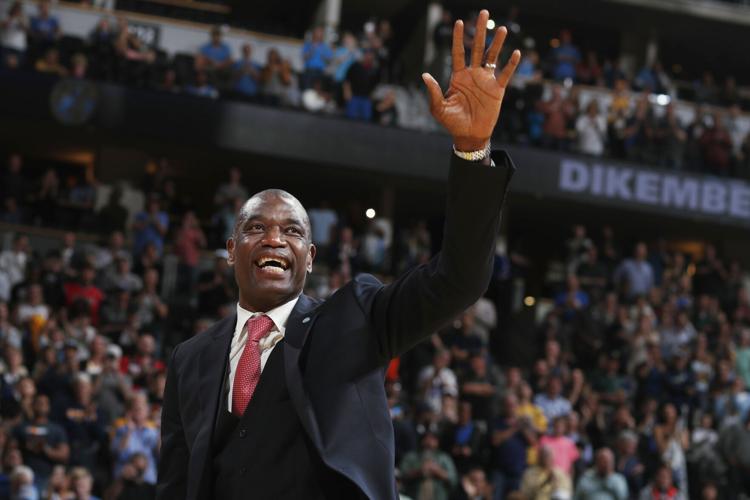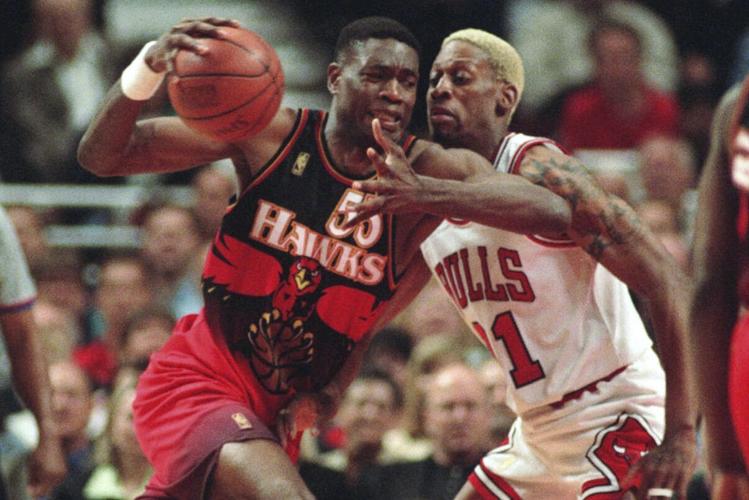The finger wag. The enormous smile. The unmistakable voice. Dikembe Mutombo played defense at a level and with a flair that few others in basketball history ever possessed, all among the many reasons why he's immortalized in the Hall of Fame.
On the court, he stopped people.
Off the court, he helped people.
In simplest terms, that is the legacy of Mutombo, the 7-foot-2 mountain of a center who died Monday, about two years after his family revealed that he was dealing with brain cancer. The tributes started when the news broke and never stopped. Current and former players. Team and league executives. Even world leaders; Barack Obama, who hosted Mutombo at the White House more than once, weighed in as did Felix Tshisekedi, the president of Congo, Mutombo's homeland.

Retired Denver center Dikembe Mutombo waves to the crowd as his jersey number is retired by the team during halftime of the Nuggets' game against the Portland Trail Blazers on Oct. 29, 2016, in Denver.
They all said the same thing in different ways. Mutombo touched lives, one way or another.
People are also reading…
“Dikembe Mutombo was an incredible basketball player — one of the best shot blockers and defensive players of all time," Obama wrote on social media Monday. “But he also inspired a generation of young people across Africa, and his work as the NBA’s first global ambassador changed the way athletes think about their impact off the court.”
When Mutombo wanted something done, it got done. He built a hospital in the Congo and that facility — named for his mother — has now treated about 200,000 people. He worked tirelessly on behalf of the Special Olympics, on behalf of UNICEF, on behalf of the Center for Disease Control and Prevention. He traveled the world, he encouraged NBA leaders to visit Africa, he fought for change. He was the first, and still is the only, person to win the NBA's J. Walter Kennedy Citizenship Award twice.
“His legacy of things that he did off of the court are going to long outlive the things he did on the court," one of his former coaches, fellow Hall of Famer Dan Issel, said Monday.
Issel coached Mutombo in Denver, where they were part of the first 8-seed-beats-1-seed upset in NBA playoff history, the one where the Nuggets ousted Seattle in 1994 in a best-of-5 series and Mutombo ended up on the floor when it was over, flat on his back, holding the ball over his head with absolute joy on his face.
That was an iconic moment. But Mutombo's iconic move was the finger wag — which he broke out after blocking a shot, his index finger going back and forth as if to say “no, no, no” to shooters who he had just rejected. It is legendary. It didn't start that way.
“He got called for a technical, I think, the first time he did it," Issel said. "And so the NBA made a rule that they liked it so much, they just didn’t want him doing it in somebody’s face. So, after that, they said, ‘Hey, if you turn to the crowd and do the finger waggle, you’ll be OK. Just don’t do it in the player’s face that you just blocked.’”

The Atlanta Hawks' Dikembe Mutombo, left, drives to the hoop against the Chicago Bulls' Dennis Rodman during the second quarter of their playoff game on May 8, 1997, in Chicago.
Mutombo spent 18 seasons in the NBA, playing for Denver, Atlanta, Houston, Philadelphia, New York and the then-New Jersey Nets. The 7-foot-2 center out of Georgetown was an eight-time All-Star, four-time defensive player of the year three-time All-NBA selection and went into the Basketball Hall of Fame in 2015 after averaging 9.8 points and 10.3 rebounds per game for his career.
His speech in Springfield, Massachusetts on the night of his induction lasted about 9 minutes. And probably 8 1/2 of those minutes were him talking about everyone else, instead of talking about his own accomplishments. He had John Thompson, his Georgetown coach, and then-former NBA Commissioner David Stern on the stage with him as his Hall of Fame presenters. From Thompson, he learned basketball and how to look at the world. From Stern, he got the opportunity to use the NBA platform to help change the world. He could not have thanked either of them enough.
“The spirit of Dikembe Mutombo is never going to be forgotten," said Philadelphia guard Kyle Lowry, who was a Mutombo teammate in the center's final NBA season — with Houston in 2008-09. “I think everyone that’s ever been around, ever been a part of, whoever met him, knows how great of a man he was. He’s got a great family, great children. It’s a big loss for our league, our world.”
There will be no more finger wags. That voice — it was compared to the Cookie Monster, and Mutombo always saw the humor in that — has been silenced. Mutombo is gone. The legacy is not. It never will be.
And if someone had to sum up Mutombo's remarkable life in one sentence, there might be no better choice than the one he himself used to wrap up his Hall of Fame speech.
“I may not have won the championship,” he said that night, “but I'm a champion to so many people.”
The 5 biggest draft busts in NBA history
The 5 biggest draft busts in NBA history

The NBA draft is one of the most important processes in building a team. Championship contenders can find their missing piece or a diamond in the rough, while lesser teams may secure a cornerstone player for the future. Scouts and teams must attend the draft combine, interviews, and workouts, and they also study, film, and watch games to get a grasp on what attributes these prospects bring to the table.
While selecting the right player in the draft could speed up a team's championship timeline, picking the wrong player could set a franchise back significantly. For example, in the 1984 draft, Hakeem Olajuwon was chosen as the first overall pick by the Houston Rockets, Sam Bowie was the second pick by the Portland Trail Blazers, and the Chicago Bulls selected Michael Jordan with the third pick.
Olajuwon retired as a two-time champion and was inducted into the Naismith Memorial Basketball Hall of Fame in 2008. Bowie's career was plagued by injuries, and his only accolade was an All-Rookie team nod. Jordan retired as a six-time champion and five-time Most Valuable Player and is widely recognized as the best player to ever enter the game. This predicament alone shows the importance of drafting the right player.
Sqore compiled a ranking of the five biggest draft busts in NBA history using Basketball Reference data. Players were ranked according to the sum of their career win shares and career value over replacement player, or VORP, two commonly used approximations of player value. For players who predated the start of VORP in 1973, career win shares were used. Only the top five picks who played at least one NBA game and are no longer active in the league were considered.

#5. Chris Washburn

- Draft year: 1986 (3rd overall pick)
- Career averages (per game): 3.1 points, 2.4 rebounds, 0.3 assists
- Games played: 72
- Player value score: -1.5 (win shares: -0.6, VORP: -0.9)
Chris Washburn played center at North Carolina State University and was a dominant force, averaging 17.6 points per game as a sophomore. Washburn was drafted by the Golden State Warriors before he was traded to the Atlanta Hawks in his second season.
He appeared in just 72 games and was suspended for the 1988-89 season because of substance abuse, his second violation of the league's drug program. Not even a year later, Washburn received a lifetime ban from the NBA after a third infraction.
Players such as Ron Harper, who was picked eighth, and Dennis Rodman, the third selection in the second round, were in the same draft and went on to have illustrious careers.
#4. Nikoloz Tskitishvili

- Draft year: 2002 (5th overall pick)
- Career averages (per game): 2.9 points, 1.8 rebounds, 0.7 assists
- Games played: 172
- Player value score: -3.6 (win shares: -1.6, VORP: -2)
Nikoloz Tskitishvili caught the eyes of NBA teams by showcasing his ability to stretch the floor and shoot the ball as a 7-footer in the Italian league and for the Georgia national team. He was selected by the Denver Nuggets and played 16.3 minutes per game as a rookie, but he never reached half that mark again.
Tskitishvili was traded to the Warriors during his third season before short stints with the Minnesota Timberwolves and Phoenix Suns.
Tskitishvili's skill set never translated to the NBA, and he was out of the league by age 23. Over the next five years, he played for teams in Spain, Italy, and Greece and followed a 2015 flirtation with the NBA by heading back overseas.
Six-time All-Star Amar'e Stoudemire was chosen by the Suns just four picks after Tskitishvili's selection in 2002.
#3. Adam Morrison

- Draft year: 2006 (3rd overall pick)
- Career averages (per game): 7.5 points, 2.1 rebounds, 1.4 assists
- Games played: 161
- Player value score: -3.8 (win shares: -1.4, VORP: -2.4)
Adam Morrison was one of the best players to ever come out of Gonzaga. He averaged a jaw-dropping 28.1 points per game as a junior and was drafted by the Charlotte Bobcats.
Morrison had a solid first season, finishing fourth in Rookie of the Year Award voting. But he tore his left ACL in the 2007-08 preseason and missed the campaign, and then the Bobcats traded him to the Los Angeles Lakers in 2009.
Morrison was never known for having elite athleticism, so the knee injury was a major setback. His last NBA season came in 2009-10, and then he played in Serbia and Turkey before a failed comeback attempt.
In the 2006 draft, both Rudy Gay and JJ Redick were selected in the eight picks after Morrison.
#2. Josh Jackson

- Draft year: 2017 (4th overall pick)
- Career averages (per game): 11.3 points, 4 rebounds, 1.8 assists
- Games played: 291
- Player value score: -4.8 (win shares: -1.7, VORP: -3.1)
After a stellar first season at the University of Kansas, Josh Jackson was selected in the draft by Phoenix. A solid scorer in college, he continued that trend during his first NBA season, making the All-Rookie second team and finishing with 13.1 points, 4.6 rebounds, and 1.0 steals per game.
Jackson was unexpectedly traded to the Memphis Grizzlies in 2019 following a disappointing second season, and he was assigned to the G League. He showed signs of a resurgence upon his return to the NBA, but he played only two more seasons.
The 2017 draft was one of the best classes in recent history, featuring All-Stars such as De'Aaron Fox, Donovan Mitchell, and Bam Adebayo, plus a host of other productive players who were also selected after Jackson.
#1. Michael Olowokandi

- Draft year: 1998 (1st overall pick)
- Career averages (per game): 8.3 points, 6.8 rebounds, 1.4 blocks
- Games played: 500
- Player value score: -6 (win shares: 2.5, VORP: -8.5)
Michael Olowokandi, who didn't play in an organized basketball game until he was 20, was more than a standout at the University of the Pacific, averaging 22.2 points, 11.2 rebounds, and 2.9 blocks per game in his final season. He was drafted first overall by the Los Angeles Clippers and earned a spot on the All-Rookie second team in 1998-99.
In 2001-02, he received four votes for the league's Most Improved Player Award, but his career spiraled after injuries and a change of scenery via free agency. Over the next four seasons, he played for the Timberwolves and Boston Celtics but was a shell of himself.
His career averages aren't bad, but they are underwhelming for a #1 pick. His ability to stick around for nine seasons contributed by far the lowest VORP of the players considered for this list.
The 1998 draft is widely recognized as one of the best drafts of all time, as Hall of Famers Vince Carter, Dirk Nowitzki, and Paul Pierce were selected in the top 10.
Story editing by Mike Taylor. Additional editing by Kelly Glass. Copy editing by Robert Wickwire. Photo selection by Clarese Moller.
This story originally appeared on Sqore and was produced and distributed in partnership with Stacker Studio.












